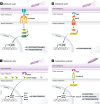Bacterial infections and cancer
- PMID: 30348892
- PMCID: PMC6216254
- DOI: 10.15252/embr.201846632
Bacterial infections and cancer
Abstract
Infections are estimated to contribute to 20% of all human tumours. These are mainly caused by viruses, which explains why a direct bacterial contribution to cancer formation has been largely ignored. While epidemiological data link bacterial infections to particular cancers, tumour formation is generally assumed to be solely caused by the ensuing inflammation responses. Yet, many bacteria directly manipulate their host cell in various phases of their infection cycle. Such manipulations can affect host cell integrity and can contribute to cancer formation. We here describe how bacterial surface moieties, bacterial protein toxins and bacterial effector proteins can induce host cell DNA damage, and thereby can interfere with essential host cell signalling pathways involved in cell proliferation, apoptosis, differentiation and immune signalling.
Keywords: bacteria; cancer; effectors; infection; signalling.
© 2018 The Authors. Published under the terms of the CC BY 4.0 license.
Figures



References
-
- Siegel RL, Jacobs EJ, Newton CC, Feskanich D, Freedman ND, Prentice RL, Jemal A (2015) Deaths due to cigarette smoking for 12 smoking‐related cancers in the United States. JAMA Intern Med 175: 1574–1576 - PubMed
-
- Koh HK, Geller AC, Miller DR, Grossbart TA, Lew RA (1996) Prevention and early detection strategies for melanoma and skin cancer. Current status. Arch Dermatol 132: 436–443 - PubMed
-
- Blot WJ, McLaughlin JK, Winn DM, Austin DF, Greenberg RS, Preston‐Martin S, Bernstein L, Schoenberg JB, Stemhagen A, Fraumeni JF Jr (1988) Smoking and drinking in relation to oral and pharyngeal cancer. Can Res 48: 3282–3287 - PubMed
Publication types
MeSH terms
Substances
LinkOut - more resources
Full Text Sources
Medical
Molecular Biology Databases

